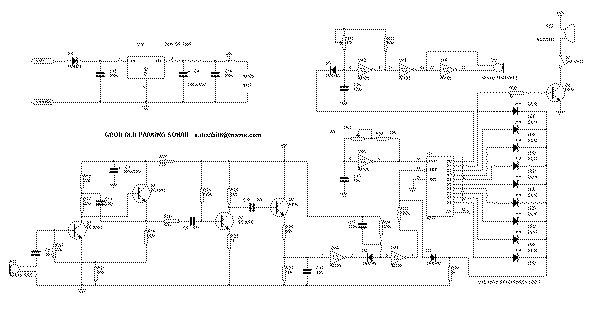Ultrasonic Parking Sonar
Feautures:
- automatic switch on on rear gear
- led-bargraph display
- audible bleep on last led
- "good old" design style, no microcontrollers!
This was one of my first designs: it is an ultrasonic parking sonar.
Based on an ultrasonic amplifier from an article seen on a 1982 magazine, it was
once installed on the rear bumper of my Volvo Station Wagon. It served very well
for many years. Connecting it to the reverse gear lights, it switches on
automatically and shows you the distance to the nearest obstacle (according to
his beam) on a led scale. When the last led lights, a buzzer is also activated
telling you to stop immediately.
It works on the sonar principle, sending an ultrasound burst and listening for first echo. The burst generated by the oscillator built around U4D (you must set the frequency using TR2 to have 40 kHz or the maximum sensitivity), U4E buffers the output and U4F boost the signal doubling the voltage span across the TX piezo transducer .
A new burst is generated each time the decade counter (4017 in the circuit diagram) is in its reset state, that is output 0 is selected. The other outputs (1 to 9) are scanned sequentially following burst generation, until an echo strikes back the RX receiver. It is then amplified by the transistor input stage, triggering the monostable built around U4A - U4B. The monostable stops temporarly the scanning, and a led corresponding to the obstacle distance appears as continuously lit. The buzzer bleeps when the first led (minimum distance) il lit.
When the monostable expires, scanning is resumed and restarting the send-and-listen sequence. If no echo is received, the scanning never stops and all the leds are slightly lit.
Figure. Ultrasonic parking sonar schematics.
To set up:
Set TR2 for maximum sensitivity (usually 40 kHz for most commercially
available ultrasonic transducer pairs).
Set TR1 for your preferred range. Setting it to minimum resistance shortens the
distance for each led (minimum range). I suggest a range of 90 cm (10 cm each
led).
Hints:
First of all, be careful not to exchange the ultrasonic transmitter with the
receiver: they look very similar, and I suggest you to mark them very clearly
from the moment you buy them.
During setup, place the ultrasonic transducers over a soft surface, near the
border of a table, 10 cm apart of each other pointing outwards the table. Then
adjust TR1 and TR2 using a rigid surface (for example a metal sheet) placed in
front of sensors, at a variable distance.
I enjoyed the sonar for many years. It was installed below the car's rear
bumper in a plastic case. Do not choose an enclosure too small: always separate
the transducers by 7-10 cm and plenty of sound-absorbing material, otherwise the
receiver will reveal the direct sound instead of the reflected one. The same
applies if the sound travels through a rigid fixture, so it is a good idea to
fix them with separated supports.
And remember not to mount the tranducers exposed to direct sunlight nor rain.
Title: Ultrasonic Parking Sonar
electronic circuit
Source: unknown
Published on: 2005-08-15
Reads: 6162
Print version: ![]()
Other electronic circuits and schematics from Automotive
-
Capacitor Discharge Ignition Circuit (CDI)
-
Car Battery Charger
-
Synchronized multi-spark module (SMSM) for Electronic Ignition Devices (EID)
-
Nite Rider Lights
-
Dome light dimmer for Cars
-
Headlight Flasher
-
Automatic Headlight Brightness Switch
-
Charge Monitor for 12V lead acid battery
-
Intermittent wiper controller
-
Speed-limit Alert

